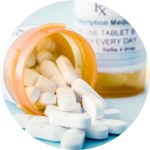
Quick Guide to Medicare Part D Prescription Drug Plans
In Triage Health's free Quick Guide to Medicare Part D Prescription Drug Plans, you'll learn about prescription drug terms, coverage, costs, getting help paying for drugs, when to enroll, and what to do if you're denied coverage.
Medicare is a government health insurance program for seniors and people with disabilities. Medicare coverage is broken up into different parts. Medicare Part A is hospital insurance, and pays for your medical care when you are staying in a hospital. Medicare Part B is medical insurance, and pays for visits to your doctor, lab tests, scans, medical equipment, and IV chemotherapy. Parts A and B together are called Original Medicare.
Medicare Part C plans, also called Medicare Advantage plans, are sold by private insurance companies. They are an alternative to Original Medicare and include services covered under Parts A and B. Medicare Part D is prescription drug coverage. Part D plans are offered by private insurance companies. If you have Original Medicare, you can buy a Part D prescription drug plan. Most Part C plans also include Part D coverage for prescription drugs. If you have a Part C plan without drug coverage, you can buy a Part D plan. For details about parts of Medicare, read our Quick Guide to Medicare – Extended or watch our Medicare Animated Video Series.
Prescription Drug Terms
There are some terms that are helpful to understand about prescription drug coverage:
- Brand-name drugs are prescription drugs with a specific name from the company that sells the drug.
- Generic drugs are prescription drugs with the same chemical substance as a brand-name drug.
- Specialty drugs are prescription drugs that have a high cost, are complex, or require special handling.
- The formulary is the list of drugs covered by a particular plan.
Medicare Part D Coverage
The formulary varies from plan to plan, and from year to year. Generally, your plan will only cover the drugs on the formulary, but it is possible to ask for an exception to have other drugs covered. If your plan does approve a non-formulary drug, you may have higher out-of-pocket costs.
Certain drugs are excluded from Part D plans, including:
- Over-the-counter medications (e.g., cough and cold medications), vitamins, and minerals
- Weight loss/gain, fertility, erectile dysfunction, cosmetic, and hair growth drugs
- Drugs purchased in another country or drugs that may be covered under Medicare Part A or B
Part D Costs
What you pay each month for a Part D plan is called your premium. Your Part D monthly premium will depend on the plan you choose and your income level. Part D has a yearly deductible, which is an amount you pay first, before the plan starts to pay anything for your prescription drugs. In 2025, the maximum deductible for a Part D plan is $590. After you pay the deductible, Medicare pays 75% of your drug costs and you pay 25%.
depend on the plan you choose and your income level. Part D has a yearly deductible, which is an amount you pay first, before the plan starts to pay anything for your prescription drugs. In 2025, the maximum deductible for a Part D plan is $590. After you pay the deductible, Medicare pays 75% of your drug costs and you pay 25%.
What you pay is called your “out-of-pocket” costs, because you pay for them out-of-your own pocket. “Out-of-pocket costs” do not include your monthly premium.
Beginning January 1, 2025, once your out-of-pocket spending reaches $2,000, you will automatically get catastrophic coverage and won’t have to pay a co-payment or co-insurance for covered Part D drugs for the rest of the calendar year.
Each month, you will get an Explanation of Benefits (EOB) notice from your drug plan. It shows how much you have paid for drugs during the period, and how much more you still need to pay to move to the next phase of coverage.
More information on Medicare costs
Understanding a plan’s formulary will save you money. Formularies may have two or more cost levels, called tiers. A drug on a higher tier will have higher costs for you. The highest tier in most formularies is the “specialty” tier, which includes many cancer drugs. The co-payment and co-insurance amounts will depend on the tier of the drug you are taking. For example, a tier 1 drug may have a $10 co-payment, while a tier 5 specialty drug may have a 30% co-insurance amount. Make sure the plan you choose covers the prescription drugs that you take.
Help Paying for Drugs
Medicare has programs that may help you pay for your drug costs. If you are eligible based on your income and resources, the Medicare Extra Help program will pay your Part D premiums, deductibles, and co-insurance amounts. This program is also called the “Low Income Subsidy.” To qualify for Extra Help, you must have Medicare Part A and/or Part B, and have resources less than $17,220, if you are not married or not living with a spouse. Your income must be less than $22,590. If approved for Extra Help, in 2025, your prescription drug costs will be no more than $4.90 for each generic drug and $12.15 for each brand-name covered drug. Also, depending on your income level, you may pay less for your Part D plan premiums and deductibles.
You can apply for Extra Help through the Social Security Administration (SSA) or the State Medicaid office. To apply for Extra Help, visit SocialSecurity.gov/extrahelp or call 800-772-1213. If you qualify for certain Medicare Savings Programs, you automatically qualify for Extra Help. For information, read our Quick Guide to Medicare Savings Programs. You will also be automatically enrolled in Extra Help if you receive Supplemental Security Income (SSI), or if you qualify for both Medicare and Medicaid. Medicaid is another government health insurance program for people who have low incomes and resources.
Other Help Paying for Drugs
If you don’t qualify for Extra Help, your state may have a State Pharmaceutical Assistance Program to help pay for Part D premiums or drug costs. There are also organizations that provide financial assistance to help with your expenses. Visit CancerFinances.org to find help with prescription drugs and other financial assistance options. The companies that make your medicines may provide support to help you understand your insurance coverage. Many of them also offer financial assistance resources such as free medication for eligible patients.
When to Enroll in Medicare Part D
You must sign up for a Part D plan when you are first eligible for Medicare, or you may have to pay a late enrollment penalty fee if you decide to buy a Part D plan in the future. But, if you have other health insurance, like from an employer, you may be able to wait to sign up for a Part D plan without a penalty.
- New Beneficiaries – if newly eligible for Medicare, you have a 7-month period to join a Medicare Part D plan, called the Initial Enrollment Period (IEP). It includes the 3 months before you turn 65, the month you turn 65, and 3 months after the month you turn 65.
- Beneficiaries with a Disability – if you have received Social Security Disability Insurance (SSDI) benefits for 24 months, you become eligible for Medicare. Your IEP is the 3 months before your 25th month of SSDI, the 25th month of SSDI, and 3 months after the 25th month of SSDI.
- Open Enrollment – you can switch Part D plans during open enrollment, between 10/15 and 12/7, each year. Coverage begins 1/1 of the next year. Review your options each year, to make sure your plan meets your needs.
- Special Enrollment – you can join a Medicare Part D plan during a special enrollment period, when you move, lose your current coverage, your plan changes contracts with Medicare, or other special situations.
- If you want to switch to a plan with a 5-star quality rating, you can do so once between 12/8 and 11/30.
- If you get Extra Help, you can join, switch, or drop your Part D plan once during January–March, April–June, or July–Sept. Changes take effect on the first day of the next month.
- If you get SPAP, you can join, switch, or drop your Part D plan once during the calendar year. Changes take effect on the first day of the next month.
- Medicare Advantage Open Enrollment – if you switch from a Medicare Advantage Plan to Original Medicare (i.e., Part A and/or Part B) and join a stand-alone Part D plan, you may do so once from 1/1 to 3/31, each year.
When a Part D Plan Denies Coverage for Your Prescription Drugs
You have the right to ask your Part D plan to cover a drug your health care provider has prescribed. If the plan denies coverage, you can talk to your provider about how you can request an exception for the drug. If your Part D plan decides not to cover the drug, you can appeal their decision. For more information about Medicare appeals, visit the Appeals Module on CancerFinances.org.
Where to Get More Help
Contact your State Health Insurance Assistance Program (SHIP) or call 1-800-MEDICARE (1-800-633-4227) and say “agent.”
Learn More
For more information, explore our Medicare Materials & Resources, and visit CancerFinances.org.
Sharing Our Quick Guides
We're glad you found this resource helpful! Please feel free to share this resource with your communities or to post a link on your organization's website. If you are a health care professional, we provide free, bulk copies of many of our resources. To make a request, visit TriageHealth.org/MaterialRequest.
However, this content may not be reproduced, in whole or in part, without the express permission of Triage Cancer. Please email us at TriageHealth@TriageCancer.org to request permission.
Last reviewed for updates: 01/2025
Disclaimer: This handout is intended to provide general information on the topics presented. It is provided with the understanding that Triage Cancer is not engaged in rendering any legal, medical, or professional services by its publication or distribution. Although this content was reviewed by a professional, it should not be used as a substitute for professional services. © Triage Cancer 2025
